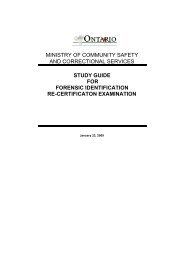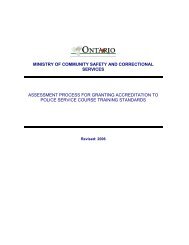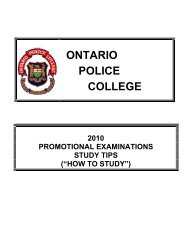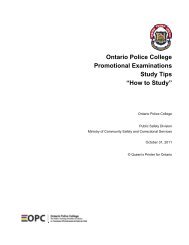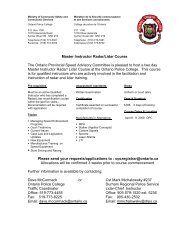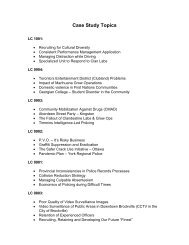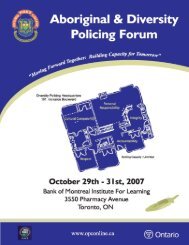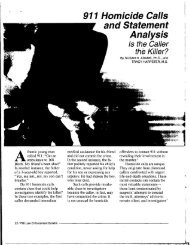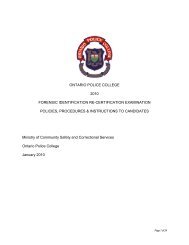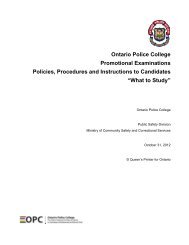General Study Guide - Ontario Police College
General Study Guide - Ontario Police College
General Study Guide - Ontario Police College
You also want an ePaper? Increase the reach of your titles
YUMPU automatically turns print PDFs into web optimized ePapers that Google loves.
Metallic powders – consist of very fine particles of various metals & should not be<br />
confused with magnetic powders. The most common contain aluminum, but copper,<br />
bronze and brass are also available, both separately and in combination. Metallic<br />
powders have the best adhering qualities of any powders commonly in use and should<br />
be given 1 st consideration.<br />
Granular Powders – appear like miniature chunks of crushed rock when viewed under a<br />
microscope. It can be used on windows, counter-tops, television sets, metal file<br />
cabinets, painted doors, broken glass and metal window frames and; painted surfaces,<br />
glass windows and mirrors in recovered stolen vehicles.<br />
Magnetic Powders– Magnetic powders are generally made by mixing iron grit with<br />
either aluminium or copper flake powder. Magnetic powders generally develop better<br />
latent prints on shiny magazine covers or boxes with a coated surface and ceramics*<br />
rather than regular powders. Some plastic materials, such as food storage containers<br />
and plastic baggies are choice surfaces for magnetic powders. (*IAI,Vol.53,No.2)<br />
“They are quite useful when examining vinyl surfaces, such as automobile interiors,<br />
because they avoid the build up of static caused by a fiberglass brush.” (OPC Training<br />
Manual)<br />
Aluminum-based –<br />
light grey,<br />
sometimes sparkly.<br />
Regular – black,<br />
silver/gray, white<br />
and Bichromatic<br />
(appear light on<br />
dark surfaces &<br />
dark on light<br />
surfaces) .<br />
Magnetic –<br />
available in same<br />
basic colours as<br />
regular powders<br />
including<br />
fluorescent.<br />
Particles stick to regular<br />
fingerprint matrix & due to<br />
electrostatic charge built up from<br />
the brushing action when using a<br />
fibreglass brush. E.C. may cause<br />
adherence problems on some<br />
plastic surfaces or ‘tacky’<br />
surfaces such as greasy windows.<br />
Powder clings to moisture, oil<br />
and other components of print<br />
residue creating a contrast<br />
between the print and the<br />
substrate. Granules do not<br />
adhere as strongly to the<br />
substrate as the metallic platelets<br />
and readily fall off. These<br />
powders also tend to act as<br />
abrasive grit and may destroy<br />
print – care must be taken during<br />
application.<br />
Application of magnetic powder<br />
requires the use a magnetic<br />
wand.<br />
Because of the probability of the<br />
wand magnetizing steel objects,<br />
they are not the first choice when<br />
examining metallic exhibits.



